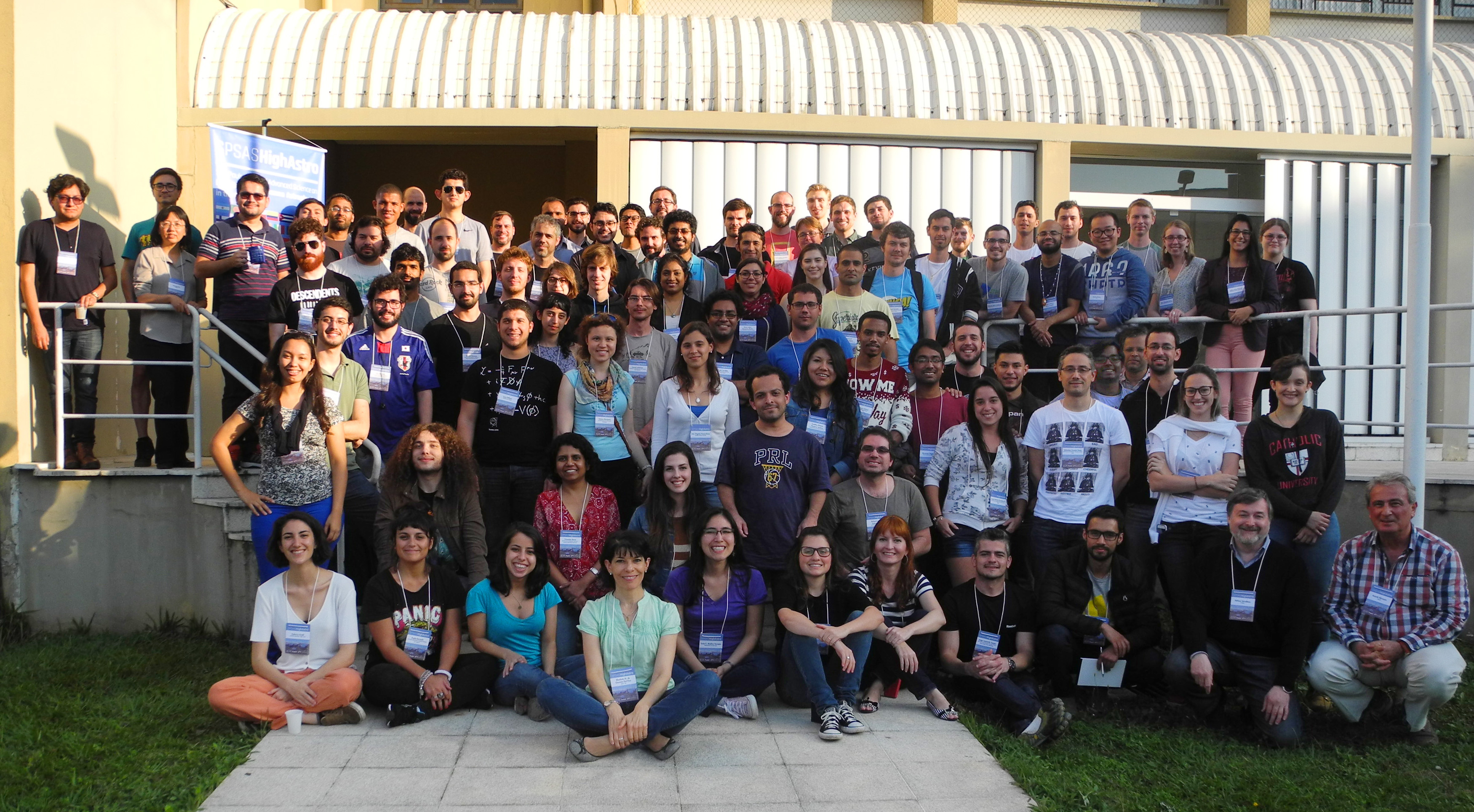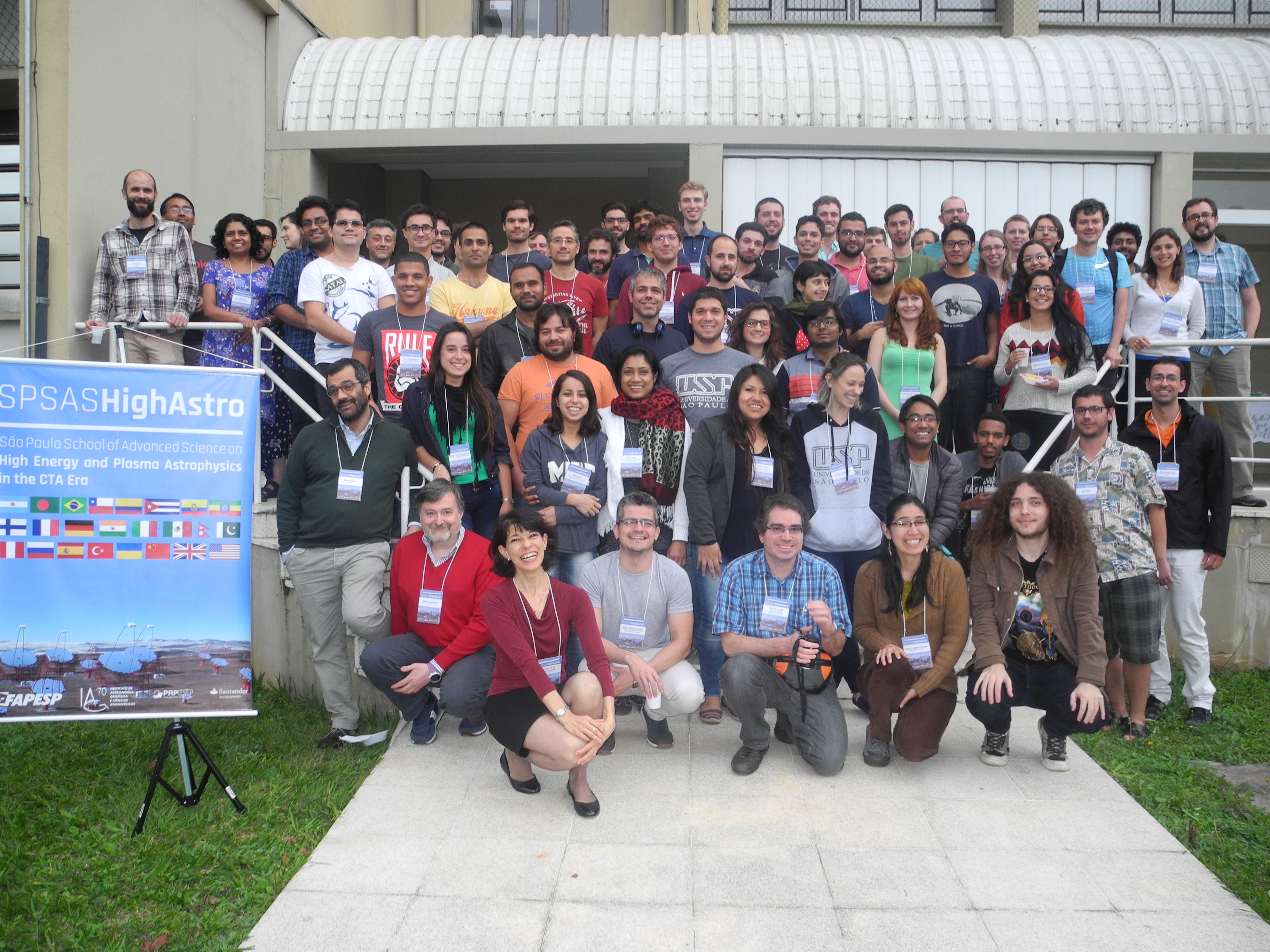Links to:
- ☞ Photo Album compiled by LOC member Paramita Barai
- ☞ Google Drive Album compiled by participant Richard Britto
- ☞ Video made by FAPESP, featuring the organizing chair Prof. Elisabete de Gouveia Dal Pino: Youtube link, Facebook link.
The Cherenkov Telescope Array (CTA) is the next generation world's largest Gamma-Ray Observatory, aimed to be constructed by 2022. It involves an international collaboration of more than 32 countries, which includes Brazil. CTA will provide the deepest insight ever reached into the non-thermal high-energy Universe. It will deliver significant contributions to Cosmology, Plasma Astrophysics, and Astroparticle Physics, yielding an intense synergy between these research areas. CTA will probe the physical conditions of cosmic ray accelerators like black hole sources, pulsars, supernovae, and gamma-ray bursts; the composition and origin of dark matter; the cosmic magnetic fields; and explore the violation of the constancy of the light speed.
The time is ripe for the organization of a school on high energy astrophysics, particularly in South America -- where the Southern site of CTA will be located (in Chile). The first General Meeting of the CTA Consortium in the American continent will be held in Rio de Janeiro, Brazil, in May-2017. We take this unique opportunity to organize the "São Paulo School of Advanced Science on High Energy and Plasma Astrophysics in the CTA Era (SPSAS-HighAstro)", to be held between 21-31 May 2017 (starting from the week after the CTA Consortium meeting).
The emphasis of SPSAS-HighAstro will be on very high energy phenomena in the Universe, and practical methodology in the solution of problems related to them. It will address questions like:
- - How are cosmic rays accelerated, and how do they propagate through the cosmic environment (from the emitting sources to our detectors on Earth)?
- - What are the particle radiation mechanisms at the highest energies?
- - How to measure and analyse the gamma-ray emission obtained with ground-based Cherenkov telescopes and space detectors?
- - How should we compare theoretical models to observational data?
SPSAS-HighAstro will cover the following topics, including:
- Radiation processes in high energy astrophysics
- Cosmic ray acceleration mechanisms
- Cosmic ray propagation
- Non-thermal radiation magneto-hydrodynamics (MHD) processes in gamma-ray sources (supernova remnants, pulsar winds, black holes, and jets)
- Imaging gamma-ray emission with air Cherenkov telescopes
- Gamma-ray data analysis with Cherenkov telescopes
- Space- versus ground-based gamma-ray astronomy: from FERMI to CTA
- Unveiling the gamma-ray Universe with the CTA
- Cosmic ray diffusion in turbulent media
- Particle acceleration by magnetic reconnection
- ASTRI Mini-Array: a CTA precursor
- High energy messengers of the non-thermal Universe
- The search for dark matter
- Brazilian participation in the CTA
- Science in São Paulo and Brazil
The school is supported by:
- ► FAPESP: São Paulo Research Foundation
- ► IAG-USP: Instituto de Astronomia, Geofísica e Ciências Atmosféricas of Universidade de São Paulo.
Invited Lecturers
| Roberto Aloisio | INAF - Arcetri Astrophysical Observatory | Italy |
| Ulisses Barres de Almeida | Centro Brasileiro de Pesquisas Físicas (CBPF), Laboratorio de Fisica de Altas Energias (LAFEX) | Brazil |
| Pasquale Blasi | INAF - Arcetri Astrophysical Observatory | Italy |
| Carlos H. de Brito Cruz | FAPESP | Brazil |
| Elisabete M. de Gouveia Dal Pino | IAG - USP | Brazil |
| Vitor de Souza | Instituto de Física de São Carlos - USP | Brazil |
| Fabio Iocco | ICTP - South American Institute for Fundamental Research, Instituto de Física Teórica - UNESP | Brazil |
| Grzegorz Kowal | Escola de Artes, Ciências e Humanidades (EACH) - USP, Universidade Cruzeiro do Sul - São Paulo | Brazil |
| Gernot Maier | DESY Zeuthen | Germany |
| Julie McEnery | NASA Goddard Space Flight Center | USA |
| Razmik Mirzoyan | Max Planck Institute for Physics - Munich | Germany |
| Rodrigo Nemmen | IAG - USP | Brazil |
| Giovanni Pareschi | INAF - Osservatorio Astronomico di Brera | Italy |
| Vladimir Ptuskin | Pushkov Institute of Terrestrial Magnetism, Ionosphere and Radio Wave Propagation (IZMIRAN) - Russian Academy of Sciences | Russia |
| Ronald C. Shellard | Centro Brasileiro de Pesquisas Físicas (CBPF) | Brazil |
| Riccardo Sturani | IIP - Universidade Federal do Rio Grande do Norte | Brazil |
| Alexander Tchekhovskoy | University of California - Berkeley | USA |
| Stefano Vercellone | INAF - IASF Palermo Observatory | Italy |
| Huirong Yan | DESY Zeuthen, University of Potsdam | Germany |

